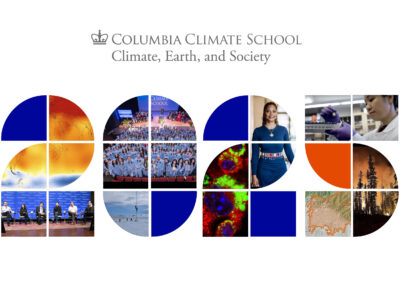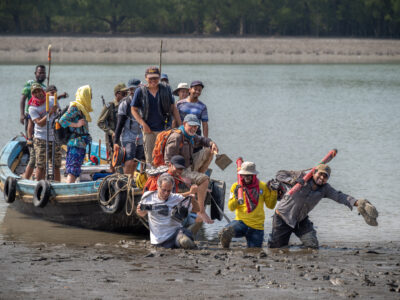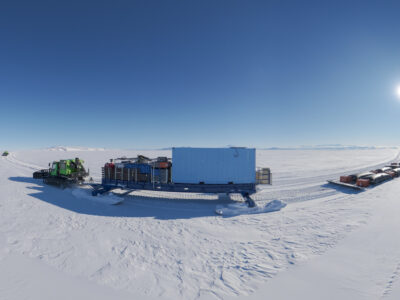The scientists at Lamont-Doherty Earth Observatory have been on the forefront of groundbreaking research in the Earth sciences for the past 75 years, raising awareness of humanity’s growing impact on the natural world—and in turn the natural world’s impact on humanity.
Founded in 1949 as the Lamont Geological Observatory, Lamont has consistently served as an international leader in scientific scholarship. Whether charting the ocean floor, measuring ocean carbon, recording global earthquakes, tracking glacier retreat or counting and decoding tree rings for clues to our planet’s climate history, Lamont researchers are continuing their search for a deeper understanding of our planet.
Below are just a few of the historic discoveries from the past seven-and-a-half decades at Lamont-Doherty Earth Observatory.

In the late 1940s, pioneering scientist Marie Tharp began collaborating with her colleague, geologist Bruce Heezen, to publish the first map of the Atlantic Ocean floor in 1957. Tharp and Heezen would go on to create the first map of the entire world’s ocean floor in 1977; a monumental achievement that lent credence to the—at the time—revolutionary theory of plate tectonics. During this period, Lamont also acquired its first oceanic research vessel, the Vema, in 1953. Research conducted onboard the Vema—extracting sediment cores from the seafloor and using new geophysical technologies to image the sub-seafloor—helped confirm the theory of plate tectonics that was being proposed by a cadre of Lamont scientists including Lynn Sykes, John Oliver, Brian Isaacs and Walter Pitman.

In 1956, Maurice Ewing, Lamont’s first director, and researcher William Donn published their influential study, “A Theory of Ice Ages” in the journal Science, which suggested that ice ages occur due to natural cycles of freezing and thawing of the Arctic Ocean. While the understanding of this phenomenon has shifted over the years, the paper marked the beginning of Lamont’s history of studying large-scale climate variation.
In 1975, Wallace Broecker, one of the founders of climate science as we now know it, published a paper that has been credited with the first peer-reviewed use of the phrase global warming.

In 1986, Mark Cane and Steve Zebiak—who would later help establish the International Research Institute for Climate and Society—published the first ocean-atmospheric model predicting El Niño’s behavior. This model enabled researchers to forecast the effects of El Niño’s impact on precipitation and temperature patterns around the world.
In 1987, Broecker popularized the concept of a global ocean “conveyor belt,” i.e., a large-scale system of ocean currents driven by differences in water temperature and salinity. Broecker linked it to global climate regulation and highlighted how disruptions like freshwater inflow from melting ice could cause sudden climate shifts. Broecker’s work built on the foundational research of Arnold Gordon, who demonstrated how temperature and salinity variations between water layers drive the exchange of water between the world’s oceans, affecting climate patterns over vast distances.

In 1988, paleoclimatologist and marine geologist Maureen Raymo, together with colleagues William F. Ruddiman and Philip N. Froelich, proposed that enhanced erosion and weathering of rocks, driven by the uplift of the Himalayas and Andes, caused a decline in atmospheric carbon dioxide. This resulted in the global cooling observed over the past 40 million years, and ultimately, to repeated ice ages. This idea is known as the Uplift-Weathering Hypothesis.

In 1995, Edward Cook, who leads Lamont’s Tree Ring Lab, demonstrated how tree rings dating back as far as 1,000 years could be linked with climate warming during the present century. Dendrochronology—or tree-ring dating—by the Tree Ring Lab has been crucial in developing “drought atlases” for North America, South America, the Mediterranean and Europe, and Asia, widely used by the scientific community.
In 2002, Lamont scientist Taro Takahashi and colleagues created the first global map showing how much carbon dioxide is exchanged between the atmosphere and oceans—a function that plays an essential role in regulating the climate.

In 2008, Peter Kelemen and Juerg Matter published a paper on using deep mantle rocks from Oman for carbon dioxide storage. They showed how natural chemical reactions can “freeze” emissions in underground mineral deposits, successfully sequestering man-made carbon dioxide.
In a 2017 paper, The Emergence of Heat and Humidity Too Severe for Human Tolerance, coauthor Radley Horton and colleagues predicted that later in this century, literal killer combinations of heat and humidity exceeding the limits of human endurance would begin popping up in various regions. This paper, published in 2020, found that such conditions are already emerging, far ahead of schedule. They are being seen in widespread regions across Asia, Africa, Australia, South America and North America.
Today, Lamont is home to 500 scientists, students and staff, including around 200 PhD-level researchers and graduate students. Lamont’s research vessel, the R/V Marcus G. Langseth, traverses the globe gathering vital data on seafloor faults and a new class of “slow” earthquakes.

Lamont’s education and outreach specialists offer hands-on learning to the community at area schools and the Hudson River Field Station, including ongoing events such as Day on the Hudson, Science Saturdays and Community Science opportunities.
And every fall, Lamont invites the public to Open House to learn more about its scientists and discoveries, and to participate in interactive (at times, explosive) exhibits, tours and lectures. Many of Lamont’s historic collections will be available to the public, including Lamont’s world-renowned core repository, which contains over 40 miles of sediment cores drawn from over 20,000 locations around the world’s oceans. The next Open House will be held on October 19.
To mark this year’s momentous anniversary, the important contributions of Lamont—past, present and future—will be highlighted throughout the coming months. Stay tuned for more coverage on State of the Planet and travel back through Lamont’s interactive timeline here.




